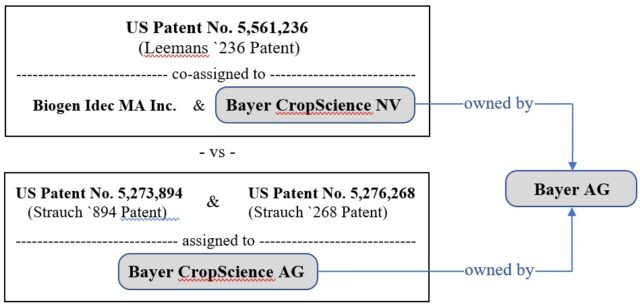A threshold issue in the context of double patenting is whether the applications/patents in question have (i) at least one common applicant, and/or are (ii) commonly assigned/owned or (iii) non-commonly assigned/owned but subject to a joint research agreement. See M.P.E.P. § 804.
On September 30, 2020, the Patent Trial and Appeal Board (“Board”) issued a decision in Ex parte Bayer CropScience NV reversing nonstatutory obviousness-type double patenting rejections issued against U.S. Patent No. 5,561,236 (“the Leemans `236 patent”), because the Examiner construed the phrase “commonly owned” to include different assignees that are wholly-owned subsidiaries of a common owner.[1]
The Examiner issued two sets of nonstatutory obviousness-type double patenting rejections against the Leemans `236 Patent—(a) double patenting rejections over U.S. Patent No. 5,273,894 (“the Strauch `894 patent”), and (b) double patenting rejections over U.S. Patent No. 5,276,268 (“the Strauch `268 patent”). Throughout the decision, the Board refers to the Strauch `894 patent and the Strauch `268 patent collectively as “the Strauch patents.”
It was undisputed by the parties that the Leemans `236 patent is currently co-assigned to both Bayer CropScience NV and Biogen Idec NA Inc., and that the Strauch patents are currently assigned to Bayer Cropscience AG—as illustrated below. It was also undisputed that the subject matter claimed in the Leemans `236 and Strauch patents is overlapping.
Although the parties agreed that the Leemans `236 and Strauch patents do not have any inventors in common, the Examiner determined that—because Bayer CropScience NV and Bayer CropScience AG are wholly-owned subsidiaries of Bayer AG—Bayer AG is a “common owner” of the Leemans `236 and Strauch patents.

The Board disagreed with the Examiner’s finding that the Leemans `236 and Strauch patents are “commonly owned” and, instead, agreed with the Patent Owners of the Leemans `236 patent that Bayer CropScience NV and Bayer CropScience AG are “two separate and independent companies.”
Citing earlier decisions by the US Supreme Court, the Federal Circuit and several District Courts, the Patent Owners argued that under U.S. law “a parent company does not own or have legal [title] to its subsidiary’s patents even when the subsidiary company is incorporated in a U.S. jurisdiction.” The Board agreed that the cases cited by the Patent Owners—including cases dealing with “choice of law”—are highly relevant to determining whether the Leemans `236 and Strauch patent are “commonly owned.”
In response to arguments made by the Examiner based on the policy justifications undergirding obviousness-type double patenting, the Board pointed out that the Federal Circuit in a related case found that the policy justifications underlying obviousness-type double patenting alone do not warrant a conclusion that the Leemans `236 and Strauch patent are “commonly owned” by Bayer AG. As explained by the Board,
Thus, for similar reasons to those relied upon in the Dow arbitration decision, the legal authority and evidence Patent Owners rely on to support their position that an overlap in ownership does not exist between the Leemans ’236 and Strauch patents is more persuasive than the Examiner’s public policy justification. We are not persuaded that Bayer AG’s alleged “beneficial ownership” of the Leemans ’236 and Strauch patents alone is sufficient to render the Leemans ’236 and Strauch patents “commonly owned” for the purposes of obviousness-type double patenting. Nor are we persuaded that the underlying policy justifications for obviousness-type double patenting show common ownership.
Judges: R.M. LIBOVITZ, R-L.P. GUEST and J.E. INGLESE (Opinion by INGLESE)
[1] See also related Ex parte Bayer Cropscience NV and Ex parte Bayer Cropscience NV issued by the Board on September 30, 2020.


